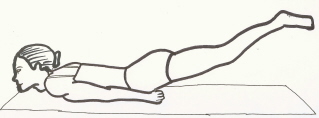Classical Hatha Yoga Asana – Locust Pose
Classical Hatha Yoga Posture
Online Hatha Yoga Asana
It is time to add some more hatha yoga asanas to our ongoing online hatha yoga poses e-book, and today we will add a classical and important posture to this resource. This pose is called Locust Pose or Shalabh Asana and it is very good for your lower back as well as toning your digestive organs. It is a slightly more difficult posture, so I will give you some nice variations below to help you practice and master this fundamental yoga pose.

This pose, as you will see below, can be practiced in the classical hatha yoga style, by holding it steady, or dynamically as well, which tends to be the kundalini yoga approach, by adding movement and dynamic breathing to it. In either case, please pay special attention to the cautions I have indicated for this posture, as it can be challenging for the beginner yogi.
Locust Pose will be part of the following 2 free online e-books here on Mastery of Meditation and Yoga: Free Hatha Yoga Poses and Online Kundalini Yoga Exercises, where you will find a large collection of other yoga poses and exercises, fully illustrated and detailed. Please also follow the guidelines on how to practice yoga, which I have detailed in the following 2 articles, Beginner’s Guide to Yoga Practice and Guidelines for Kundalini Yoga Practice. Also, be on the lookout for more free online yoga classes which are going to incorporate sets which use this classical pose in the very near future.
Classical Hatha Yoga Pose – Locust Pose
Illustration for Locust Pose
Classical Hatha Yoga’s Shalabh Asana:
a. Basic Instructions for Hatha Yoga Locust Pose:
- Start by lying flat on your stomach, with your chin on the floor.
- Have your hands in fists and place them underneath your body at the point where your hips and torso meet. As a variation to this hand position, you can also have you hands along your body, with your palms facing down, instead of tucked underneath in a fist.
- Close your eyes.
- Now push down with your hands against the floor and at the same time raise both your legs up as shown in the illustration above. Only raise your legs as far up as comfortable.
- Hold this position, which breathing deeply through the nose.
- Lower your legs and release your arms once you are done with the pose and rest on your right cheek.Variation for Beginners:
- If you are just starting yoga or starting to practice this pose for the first time, start with lifting just one leg at a time, instead of both. As you get stronger and more fit you can move to the classical locust pose as I described above.Dynamic Locust Pose:
- Once you can do the classical version described above, you can try the dynamic version of this posture as well. In this variation, lift your legs up as you inhale and then lower them as you exhale. Continue this dynamic motion for the duration of the exercise.Locust Pose with Dynamic Breathing:
- Another variation is to hold the classical pose illustrated above, and then do Breath of Fire Breathing Exercise with holding this posture. This too is a very good variation to this pose.
- Finally, you can also do the dynamic movement of the legs going up and down, which doing breath of fire at the same time. Now you are practicing some serious Kundalini Yoga
 .
.
b. Duration for Hatha Yoga Locust Pose: 10 seconds – 3 mins
c. Benefits of Hatha Yoga Locust Pose:
- Excellent for strengthening your lower back muscles.
- Tones all the digestive organs and excellent for the digestive system.
- Promotes stress relief and deep relaxation.
- Strengthens and firms the hamstrings and buttocks.
- Increases flexibility in the lower body.
d. Practice Tips and Cautions for Classical Hatha Yoga Locust Pose:
- Although this exercise is great for you back, if you have major back issues you should proceed with caution. For minor back issues, this exercise can be used as an effective treatment.
- As this pose increases blood flow and puts pressure on the heart, you should be cautious if you have high blood pressure or major cardiovascular issues.
- Feel free to take breaks in between the leg raises to allow your muscles to recover while you develop your strength and stamina.
Other great exercises for the back and digestive system are the following:
Spinal Twists for the Lower Back




Trackbacks & Pingbacks
[…] Classical Hatha Yoga Asana – Locust Pose […]
Leave a Reply
Want to join the discussion?Feel free to contribute!